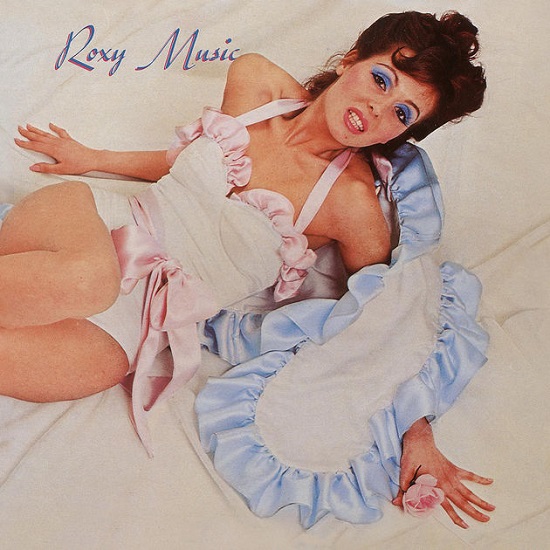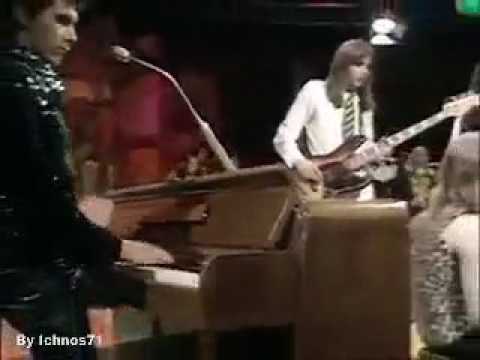In some ways, Roxy Music’s unconventional self-titled first album from 1972 is the postmodern musical equivalent of a Richard Hamilton collage, juxtaposing seemingly incongruous elements to create a work that is provocative and groundbreaking. (The comparison is not coincidental: Hamilton taught Bryan Ferry at Newcastle University during the ’60s). And just like Hamilton’s most famous work, “Just what is it that makes today’s homes so different, so appealing?”, the Roxy Music album is a sprawling canvas of disparate musical styles that pays homage to the past while looking towards the future; thematically, the debut basks in the celebration (and even hedonism) of the good life but also commenting on it with irony and detachment – as well as introducing Ferry’s ruminations on romantic angst and heartbreak.
Similarly to The Velvet Underground and Nico, Roxy Music – now reissued as a 45th anniversary lavish deluxe set – is really ahead of its time for challenging rock’s status quo. it remains a brash and experimental work that proved influential on future generations of musicians in the worlds of punk, post-punk, new romanticism and contemporary electropop. And not just for the songs – Roxy Music is also literally art for its memorable fashion magazine-like cover with model Kari-Ann Muller in a pin-up pose and awashed in cotton candy colours.
In his notes for the new reissue, Richard Williams writes of that striking image: “This was nothing less than a challenge, bold and direct, to the prevailing complacency.” That sentiment could also apply to the album’s contents, summed up perfectly on the opening track ‘Re-Make/Re-Model’. Introduced by the sounds of people chatting away as if the listener is eavesdropping on some high-brow party, ‘Re-Make/Re-Model’ is a raucous musical statement of intent: the track in one instance leans pays tribute ‘50s rock and roll and R&B, while the whirling electronic noises sound like something from outer space. Similarly, ‘Would You Believe?’ is greaser rock with its amalgam of doo-wop, Jerry Lee Lewis, and Little Richard in one irreverent package. And although it didn’t appear on the album in its original release, Roxy’s memorable single ‘Virginia Plain’ (which is included on this boxed set), is the spiritual cousin of ‘Re-make/Re-model’ in exuding a youthful stomping energy that’s typical of the glam rock era.
Aside from those aforementioned relatively straightforward rockers, the rest of the album is quite eclectic. The romantic seduction of ‘Ladytron’ pits Brian Eno’s buzzing synth and Andy Mackay’s high-pitch oboe against Paul Thompson’s galloping drums and Phil Manzanera’s thunderous guitar; and the bouncy country-meets-funk of ‘If There Is Something’ highlights Ferry’s anguished and desperate crooning, forever cementing his reputation as rock’s ultimate lounge lizard and matinee idol. Some of Roxy Music’s other tracks showcase dramatic shifts in tempo and mood, such as the experimental “The Bob (Medley)” and “Sea Breezes,” while the dreamy and haunting ballads “2HB” (an ode to Humphrey Bogart) and “Chance Meeting” provide moody and reflective counterpoint. The album ends on a whimsical and witty note with “Bitters End,” which is notable for perhaps being the first song on a rock album to use the word ‘cognoscenti’ in its lyrics.
There’s a lot to absorb from the previously unreleased material on this new deluxe edition of Roxy Music. For instance, there are a couple of demos dating back to 1971 from the early band lineup of Ferry, Mackay, Eno, Simpson and drummer Dexter Lloyd and guitarist Roger Bunn (the arrival of Mananzera and Thompson a year later represented a tremendous leap forward musically). Additionally, the album outtakes reveal tracks being fleshed out in the studio: in some instances, Eno’s sonic treatments seem more pronounced on the outtakes than what ended up on the record, such as the intro on ‘Ladytron’; ‘Chance Meeting’ is presented as a mostly piano-and-bass showcase minus the vocals, but no less mesmerizing. There’s also a very brief but intriguing untitled instrumental piece, and the band breaks out into a spontaneous 1920s jazz-inspired improvisational jam during the recording of ‘The Bob’.
Also included on the reissue are the group’s performances from their various Peel Sessions (some featuring Manzanera’s predecessor David O’List) appearances taped prior to and after Roxy Music’s recording; they’re almost letter-perfect renditions of the final studio tracks. A 1972 BBC concert demonstrates what an exciting outfit this early incarnation of Roxy was like onstage. The DVD portion of the set collects some of the band’s early TV appearances, including from Top of the Pops and The Old Grey Whistle Test, accompanied by a new 5.1 mix of the original album by Steven Wilson.
Molded in his vision, the debut album introduced Bryan Ferry as the focal point of Roxy Music with his lounge lizard singing and romantically yearning lyrics. Yet as much as Ferry dominated the proceedings on the record, as well as the band’s career direction, the other band members can’t be overlooked in contributing to the music’s controlled chaos: from Phil Manzanera’s stinging guitar attack and Andy Mackay’s blistering sax and mellifluous oboe playing, to the muscular drumming of ‘The Great’ Paul Thompson and the rhythmic bass playing of the late Graham Simpson, who departed from the group shortly after the release of the first album. Undoubtedly Ferry’s foil within the band was Brian Eno, the breakout performer on the debut record. His fussy sonic treatments – from the dazzling noises on ‘Re-Make/Re-Model’ and ‘Virginia Plain’, to the ambient textures for ‘The Bob’ and ‘Ladytron’ – gave the music an avant garde edge that complemented the other band members’ straightforward performances. Those effects made the songs on Roxy Music feel ‘new’ rather than outdated. Based on his work on that record, one could tell in hindsight that Eno, an artist with his own unique vision like Ferry’s, would leave the fold, which he did after Roxy’s second album For Your Pleasure.
For 10 years following the debut record, the group’s sound evolved into something more accessible, slick and pop-oriented (ie, the lush and equally renowned Avalon from 1982 is the standout example). Therefore, Roxy Music – with its daring merger of different sounds and styles – is an anomaly in the group’s consistently rich body of work. Forty-five years later, it still offers something to discover with each listen and pleasantly challenges, like those early Velvet Underground records. Even the late Simon Puxley posed this question in his cut-and-paste-styled liner notes from the original album: “Is this a recording session or a cocktail party?”



